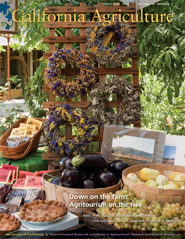All Issues

Down on the farm: Agritourism on the rise
Cover:
Agritourism can provide growers with access to new customers as well as bolster income. The first statewide survey of agritourism operators found that nearly 80% engage in direct sales. At its annual Pleasure of the Peach Day, Good Humus Farm in the Capay Valley offered a range of farmstead products. During recent agritourism workshops, participants discussed the growing role of social media for marketing farms and their products. Photo: Nancy Warner
April-June 2011
Volume 65, Number 2
Volume 65, Number 2
News and opinion
General Information
ANNOUNCEMENT
Hilgardia digitization project under way





